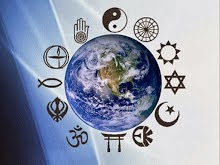It is much in vogue that Hinduism is a polytheistic due to
multiplicity of deities.There is bewildering diversity in Hinduism and
thus, some belief - theistic, atheistic and agnostic - rests on a solid
unity i,e "Ekam sath, Vipraah bahudhaa vadanti", says the Rig
Veda: The Truth (God, Brahma, etc) is one, scholars call it by various
names.If you are searching for the answer of "Multiplicity of deities"
then here is the answer, the multipicity of deities indicates the
Hinduism's spiritual hospitality as evidenced by two characteristically
Hindu doctrines:- The Doctrine of Spiritual Competence (Adhikaara) and
the Doctrine of The Chosen Deity (Ishhta Devata). The doctrine of
spiritual competence requires that the spiritual practices prescribed to
a person should correspond to his or her spiritual competence. The
doctrine of the chosen deity gives a person the freedom to choose (or
invent) a form of Brahman that satisfies his spiritual cravings and to
make it the object of his worship. It is notable that both doctrines are
consistent with Hinduism's assertion that the unchanging reality is
present in everything, even the transient.
In Hinduism many concepts are there which are interconnected to the achievements of modern science and some are there which are not.But Hinduism offers methods to correct and transform itself in course of time.According to Samkhya,the oldest school of Hindu philosophy talks about a particular method to analyze knowledge.It says that every knowledge is possible through three pramanas such as:-
In Hinduism many concepts are there which are interconnected to the achievements of modern science and some are there which are not.But Hinduism offers methods to correct and transform itself in course of time.According to Samkhya,the oldest school of Hindu philosophy talks about a particular method to analyze knowledge.It says that every knowledge is possible through three pramanas such as:-
1.Pratyaksa or Drstam (direct sense perception)
2. Anumana (logical inference) and
3.Sabda or Aptavacana (verbal testimony)
The Hindu school of logic or Nyaya accepts all these three means and in addition one more- upamana (comparison). Evolution, creationism and the origin of life are the viewpoints regarded to evolution.Some Hindu schools do not treat the scriptural creation myth literally and some creation stories also do not have specific detail.But some Hindu find Vedas and some other scriptures more accurate. Dashavatara (incarnation of lord vishnu) is almost identical to the scientific explanation of biological evolution of man and animals.Lets see what dashavatara actually is? So, it goes like-
1.Matsya (an aquatic organism)
2. Kurma (an amphibian or reptiles)
3.Varah (a land animal)
4. Narasimha (a humanoid)
5. Vamana (a dwarf human)
Above 5 forms are required for a well developed human beings.But it further mentioned while giving the name of some of the great warriors of India as Parashurama (Axe-man), Rama (King), Balarama/Buddha (Plougher/sage), Krishna (Wise statesman), Kalki (might warrior).
Now let me compare above 5 given stages of evolution with mordern biology.Lets see what science says about it:-
1.Matsya - If we compare it with biological evolution on different Geological Time Scale (G.T.S) then first developed was also in form of fish which originated during Cambrian period.
2. Kurma - In geology also first reptiles comes as second important evolution which originated in Mississippian period just after Amphibians.
3.Varah - Same evolution of Amphibian to the land animal.
4 Narasimha - There is no any evidence regarding to this stage in geology but it may have been related to Ape man or extinct early man ancestors,such as missing link between apes and human,search is under consideration but in my opinion its true as many characters are there which are missing and sometime they have been seen in Himalayas and their foot prints were also there but no prove is there of there existence now.
5.Vamana - Related to first man originated during Pliocene.It may be related with Neanderthals (12-14 cm long humans).
Now Parashurama,the man with an axe was the sixth avatar,it has similarities with the first morden man originated during the Quaternary period or the man of iron age.
LORD VISHNU - Sleeping Narayan
LORD VISHNU - Sleeping Narayan
" Lord Vishnu is said to rest in the coils of Ananta, the great serpent of Infinity, while he waits for the universe to recreate itself.
"he falls back upon the earliest and greatest of Revelations, those of the Sacred Books of India with a Cosmogony which no European conception has ever surpassed."
"While the West was still thinking, perhaps, of 6,000 years old universe – India was already envisioning ages and eons and galaxies as numerous as the sands of the Ganges. The Universe so vast that modern astronomy slips into its folds without a ripple.”
Despite the dawn of Enlightenment and advent of modern science, the Semitic religions have still not matured enough to respect, tolerate and understand a simple notion that “All paths lead to the same summit (God).”
photo courtesy: Dr. Deepak Shimkhada.
(image source: A Tribute to Hinduism: Thoughts and Wisdom spanning continents and time about India and her culture - By Sushama Londhe). "
"he falls back upon the earliest and greatest of Revelations, those of the Sacred Books of India with a Cosmogony which no European conception has ever surpassed."
"While the West was still thinking, perhaps, of 6,000 years old universe – India was already envisioning ages and eons and galaxies as numerous as the sands of the Ganges. The Universe so vast that modern astronomy slips into its folds without a ripple.”
Despite the dawn of Enlightenment and advent of modern science, the Semitic religions have still not matured enough to respect, tolerate and understand a simple notion that “All paths lead to the same summit (God).”
photo courtesy: Dr. Deepak Shimkhada.
(image source: A Tribute to Hinduism: Thoughts and Wisdom spanning continents and time about India and her culture - By Sushama Londhe). "




0 comments:
Post a Comment